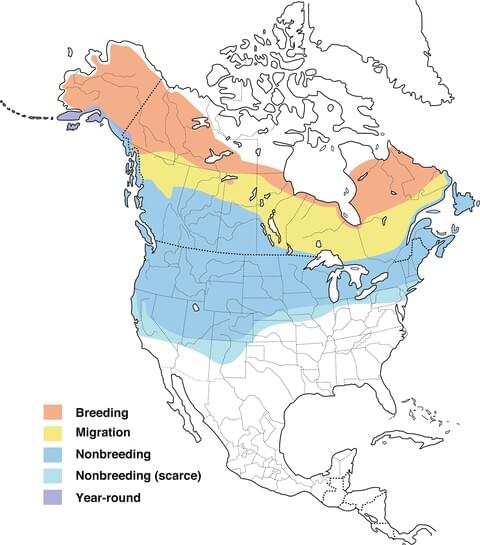My first day up north after the Solstice - I heard a bird call in the mini-forest that I did not recognize! Of course I don't know all the songs and calls but this one was really wild - very loud and an amazing sound - the timbre indescribable.
If you listen to the above Shrike sounds - it is like a catbird - it imitates OTHER bird songs. But the Songs it is imitating are very bizarre to me.
Oh it was the CALL that I first heard!! Yes. - that's the third recording. I heard the SONGS when I saw the bird. I had ID'd this bird last year or the year before - it likes the edges of forest. I think it was last year that I read up on it. So it also flies into the mini-forest as well. But it hangs out on the edge.
a harsh ack (directed at most birds), a whistled breezeek (directed at raptors or other shrikes), or a jaylike jaay (directed at mammals). Nesting shrikes are very vocal; they use nasal wake and woot calls during courtship feeding and when feeding young, as well as a variety of other calls in different contexts.This vid boasts amazing close up footage of the Shrike - by feeding it some liver!
I didn't really watch it - but I watched the Shrike closely in the wild - so I didn't need to see the vid. The beak is curved like a predator bird for sure. You can see how that curved beak just tears apart the flesh for food.
The small bird Impales its prey and will imitate other bird songs to LURE them in
it's less clear whether shrikes imitate the songs of other birds to lure them. The earliest written reference to the idea was in 1486, in the falconry and hunting instruction manual, Boke of Saint Albans:
She will stand at perch upon some tree or poste, and there make an exceedingly lamentable crye and exclamation…all to make other fowles to thinke that she is very much distressed and stands in need of ayde; whereupon the credulous sellie birds do flocke together at her call. If any happen to approach neare her, she…ceazeth on them, and devoureth them (ungrateful subtill fowle) in requital for their simplicity…
(Image is from the Boke of Saint Albans.)
DANG - that's really wild and pretty creepy.The great grey shrike is the largest of the European shrikes.
If Great Grey Shrikes turn out to lure in prey by imitating its song, it's possible that related Loggerhead Shrikes do too, though it's a little
less likely, since they don't sing all winter like Great Grey Shrikes.
And here's the citation for Atkinson's study:
Atkinson, Eric C. "Singing for your supper: acoustical luring of avian prey by northern shrikes." Condor (1997): 203-206.
Females may scold (with special calls) or even threaten (with displays) males that do not provide meals quickly enough. When females signal displeasure, males crouch and flutter the wings and tail, sing with head pointed skyward, or simply depart to continue hunting. Males sometimes perform similar displays when presenting food or just afterward.https://www.allaboutbirds.org/guide/Northern_Shrike/lifehistory
there we go - the females in control.
they attack birds as large as ducks and grouse.Oh wow - I had a grouse living right in the SAME area of the mini-forest! No more - probably got chased off by the Shrike!
When nesting they defend a large area around the nest (about 7 acres), but their hunting territory may exceed 360 acres, a very large territory for a songbird.Wow - so I saw the Shrike last year in the same area - must nest right around there.
Truly a Northern bird indeed!! I've never noticed a Shrike in the southern-central part of Minnesota....So they migrate south in the winter and breed way up north? So... the Shrike is probably just migrating through? NO - it's too late for that. Northern Minnesota must be the edge of its breeding habitat.....
So that's the search results for Sax Zim Bog - one of the biggest winter birding sights in the world - in northern Minnesota.Northern Hawk Owl: At least 3 (possibly up to 5) have been seen in the Bog all winter. Best bets are at the ... Northern Shrike: Quite common. Best areas are ...
I found a Northern Shrike hunting a feeder up in the Bog this morning. This bird may look small (about the size of a Robin), but is means death for songbirds and mice.https://www.365daysofbirds.com/tag/sax-zim-bog/page/4/
Maybe it's a Loggerhead Shrike that came north to breed?
https://www.allaboutbirds.org/guide/Loggerhead_Shrike/maps-range
Sure Enough - the Loggerhead Shrike is SEEN in northern minnesota in the summer! Wow!!
https://mn.audubon.org/sites/default/files/birdlistformat_saxzimbogiba.pdf
the Loggerhead Shrikes they normally see, which have a larger, much more pronounced facial mask and a beak that seems bigger somehow.https://blog.lauraerickson.com/2020/01/northern-shrike-at-bog.html
Loggerhead Shrike song/call - youtube
https://www.allaboutbirds.org/guide/Loggerhead_Shrike/sounds


No comments:
Post a Comment